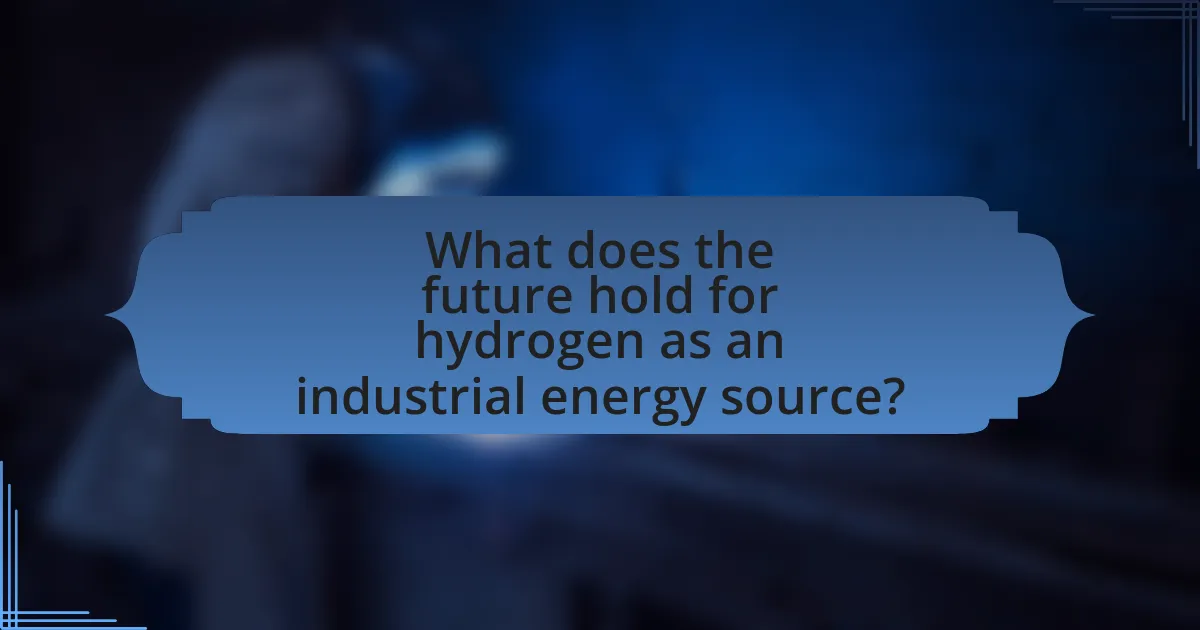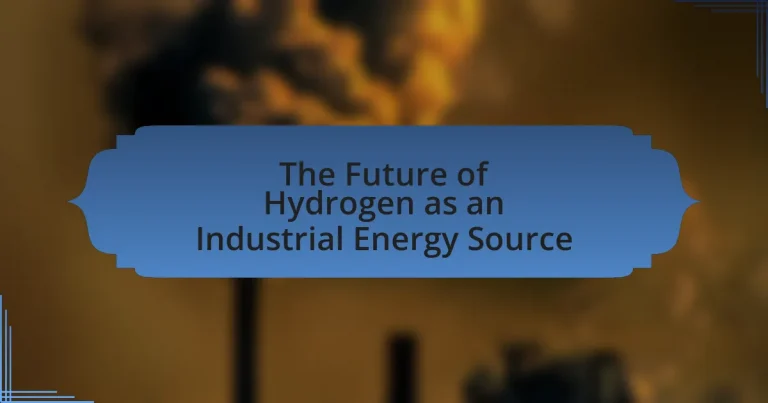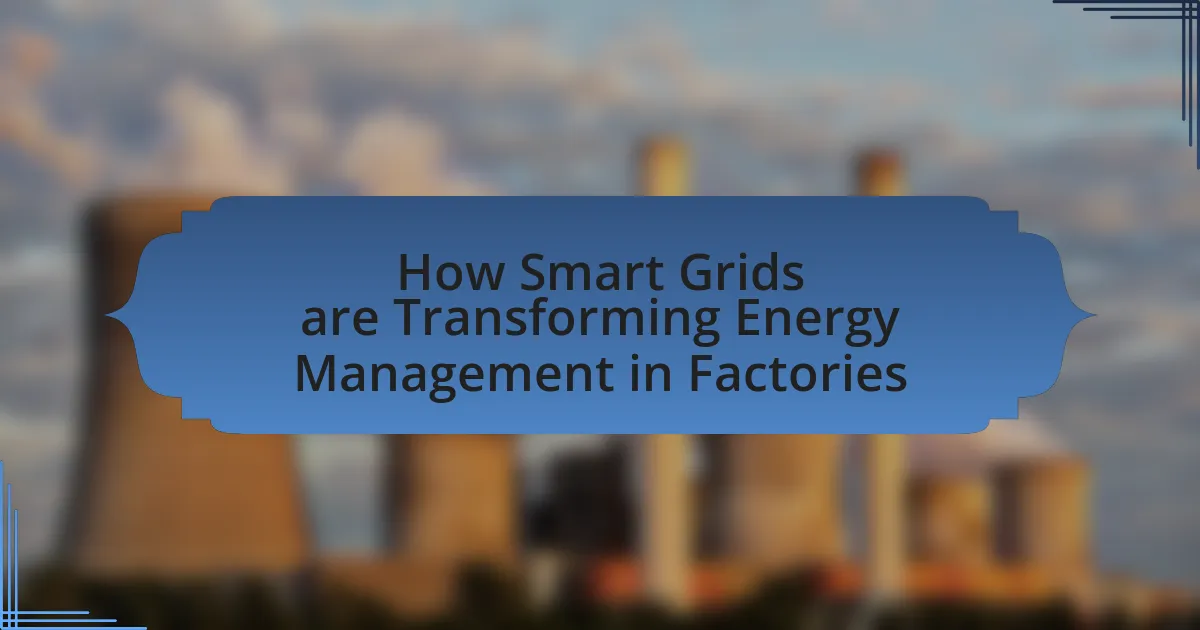Hydrogen is emerging as a significant industrial energy source, with applications in fuel cells, chemical production, and refining processes. The article explores various hydrogen production methods, including steam methane reforming, electrolysis, and gasification, while assessing their environmental impacts and safety considerations. It highlights hydrogen’s key properties that make it suitable for industrial use, compares it to traditional energy sources, and discusses current applications across multiple industries. Additionally, the article addresses the challenges of adopting hydrogen, including economic barriers and infrastructure limitations, and outlines future advancements and strategies for industries to transition to a hydrogen-based energy system.
What is Hydrogen as an Industrial Energy Source?

Hydrogen is a versatile industrial energy source that can be utilized for various applications, including fuel cells, chemical production, and as a feedstock in refining processes. Its ability to produce energy with water as the only byproduct when used in fuel cells makes it an attractive option for reducing greenhouse gas emissions. According to the International Energy Agency, hydrogen production could potentially account for 18% of global energy demand by 2050, highlighting its growing significance in the energy landscape.
How is hydrogen produced for industrial use?
Hydrogen is primarily produced for industrial use through methods such as steam methane reforming (SMR), electrolysis, and gasification. Steam methane reforming, which accounts for about 95% of hydrogen production, involves reacting natural gas with steam at high temperatures to produce hydrogen and carbon dioxide. Electrolysis, a method gaining traction, uses electricity to split water into hydrogen and oxygen, offering a cleaner alternative when powered by renewable energy sources. Gasification converts carbon-rich materials, such as coal or biomass, into hydrogen and carbon monoxide through high-temperature reactions with steam and oxygen. These methods are essential for meeting the growing demand for hydrogen in various industries, including refining, ammonia production, and fuel cells.
What are the primary methods of hydrogen production?
The primary methods of hydrogen production are steam methane reforming, electrolysis, and gasification. Steam methane reforming, which accounts for about 95% of hydrogen production, involves reacting natural gas with steam to produce hydrogen and carbon dioxide. Electrolysis uses electricity to split water into hydrogen and oxygen, offering a clean method when powered by renewable energy. Gasification converts carbon-containing materials, such as coal or biomass, into hydrogen and carbon monoxide through high-temperature reactions with steam and oxygen. These methods are essential for meeting the growing demand for hydrogen in various industrial applications.
How do these methods impact the environment?
Hydrogen production methods significantly impact the environment through their carbon emissions and resource consumption. For instance, steam methane reforming, a common method for hydrogen production, emits substantial CO2, contributing to greenhouse gas effects. In contrast, electrolysis, particularly when powered by renewable energy sources, offers a cleaner alternative, producing no direct emissions. According to the International Energy Agency, transitioning to green hydrogen could reduce global CO2 emissions by up to 6 gigatons annually by 2030, highlighting its potential for environmental benefits.
What are the key properties of hydrogen that make it suitable for industrial applications?
Hydrogen possesses several key properties that make it suitable for industrial applications, including its high energy content, versatility, and clean combustion. With an energy content of approximately 33.6 kWh per kilogram, hydrogen is one of the most energy-dense fuels available, making it efficient for various energy-intensive processes. Additionally, hydrogen can be utilized in diverse applications such as fuel cells, ammonia production, and refining processes, showcasing its versatility across different sectors. Importantly, when hydrogen combusts, it primarily produces water vapor, resulting in minimal greenhouse gas emissions, which aligns with global sustainability goals. These properties collectively support hydrogen’s role as a promising industrial energy source.
How does hydrogen compare to traditional energy sources?
Hydrogen is a cleaner alternative to traditional energy sources like coal, oil, and natural gas. Unlike fossil fuels, which emit greenhouse gases when burned, hydrogen produces only water vapor as a byproduct when used in fuel cells. According to the International Energy Agency, hydrogen can reduce carbon emissions significantly, with potential reductions of up to 80% in certain applications. Additionally, hydrogen can be produced from renewable sources, such as water electrolysis powered by solar or wind energy, further enhancing its sustainability compared to traditional energy sources that rely on finite resources.
What are the safety considerations when using hydrogen?
Safety considerations when using hydrogen include its flammability, potential for leaks, and the need for proper storage and handling. Hydrogen is highly flammable and can ignite easily in the presence of an ignition source, which necessitates strict adherence to safety protocols during its use. Additionally, hydrogen is colorless and odorless, making leaks difficult to detect; therefore, implementing leak detection systems is crucial. Proper storage requires using materials that can withstand hydrogen’s properties, as it can embrittle certain metals. These considerations are supported by safety guidelines from organizations such as the National Fire Protection Association, which emphasizes the importance of risk assessments and safety measures in environments where hydrogen is utilized.
What are the current applications of hydrogen in industry?

Hydrogen is currently applied in various industrial sectors, primarily in refining, ammonia production, and fuel cells. In the refining industry, hydrogen is utilized to remove sulfur from fuels, enhancing their quality and meeting environmental regulations. The production of ammonia, which is essential for fertilizers, relies heavily on hydrogen through the Haber-Bosch process, where hydrogen reacts with nitrogen. Additionally, hydrogen fuel cells are increasingly used in transportation and stationary power generation, providing a clean energy alternative with water as the only byproduct. These applications underscore hydrogen’s critical role in advancing industrial processes and supporting sustainability initiatives.
Which industries are currently utilizing hydrogen as an energy source?
The industries currently utilizing hydrogen as an energy source include the chemical industry, transportation, power generation, and metallurgy. The chemical industry primarily uses hydrogen for ammonia production, which is essential for fertilizers. In transportation, hydrogen fuel cells are employed in vehicles, providing a clean alternative to fossil fuels. Power generation utilizes hydrogen in fuel cells and as a means to store renewable energy. Additionally, the metallurgy sector uses hydrogen in processes like direct reduction of iron ore, reducing carbon emissions associated with traditional methods. These applications demonstrate the growing role of hydrogen across various sectors, driven by the need for cleaner energy solutions.
How is hydrogen used in the chemical industry?
Hydrogen is primarily used in the chemical industry for the production of ammonia through the Haber-Bosch process, which combines hydrogen with nitrogen. This process is essential for creating fertilizers, with approximately 80 million tons of ammonia produced annually, highlighting hydrogen’s critical role in global food production. Additionally, hydrogen is utilized in refining petroleum, where it helps remove sulfur from fuels, thereby improving their quality and reducing emissions. The versatility of hydrogen in these applications underscores its importance in the chemical sector and its potential for future energy solutions.
What role does hydrogen play in the transportation sector?
Hydrogen serves as a clean fuel alternative in the transportation sector, primarily through hydrogen fuel cell vehicles (FCVs) that convert hydrogen into electricity to power electric motors. This technology enables zero-emission transportation, significantly reducing greenhouse gas emissions compared to traditional fossil fuel vehicles. According to the International Energy Agency, hydrogen could account for up to 18% of total energy demand in the transportation sector by 2050, highlighting its potential to decarbonize heavy-duty transport, shipping, and aviation.
What are the challenges faced by industries in adopting hydrogen?
Industries face several challenges in adopting hydrogen as an energy source, primarily including high production costs, infrastructure limitations, and safety concerns. The production of hydrogen, especially green hydrogen, is currently expensive due to the reliance on renewable energy sources and electrolysis technology, which can limit its economic viability. Additionally, the existing infrastructure for hydrogen distribution and storage is underdeveloped, making it difficult for industries to transition from traditional fuels to hydrogen. Safety concerns also arise from hydrogen’s flammability and the need for stringent regulations and standards to ensure safe handling and usage. These factors collectively hinder the widespread adoption of hydrogen in industrial applications.
How do infrastructure limitations affect hydrogen use?
Infrastructure limitations significantly hinder hydrogen use by restricting production, storage, and distribution capabilities. For instance, the lack of widespread hydrogen refueling stations limits the adoption of hydrogen fuel cell vehicles, as consumers are less likely to invest in vehicles without accessible refueling options. Additionally, inadequate pipeline networks for transporting hydrogen restrict its availability to industrial users, which can stifle growth in sectors that could benefit from hydrogen as a clean energy source. According to the Hydrogen Council, achieving a robust hydrogen economy requires substantial investment in infrastructure, estimated at $70 billion to $100 billion by 2030, to develop the necessary facilities and networks.
What are the economic barriers to hydrogen adoption?
The economic barriers to hydrogen adoption include high production costs, limited infrastructure, and market competition. High production costs stem from the current reliance on fossil fuels for hydrogen generation, which can be more expensive than renewable energy sources. Limited infrastructure, such as the lack of refueling stations and distribution networks, hinders the widespread use of hydrogen. Additionally, market competition from established energy sources, like natural gas and electricity, makes it challenging for hydrogen to gain a foothold in the energy market. These factors collectively impede the transition to hydrogen as a viable industrial energy source.
What does the future hold for hydrogen as an industrial energy source?

The future of hydrogen as an industrial energy source is promising, with significant potential for growth and adoption. Hydrogen is increasingly recognized for its ability to decarbonize various sectors, including steel production and chemical manufacturing, where traditional fossil fuels are currently dominant. According to the International Energy Agency, hydrogen could account for 18% of global energy demand by 2050, driven by advancements in production technologies and supportive government policies. Furthermore, investments in hydrogen infrastructure are rising, with countries like Germany and Japan leading initiatives to develop hydrogen economies. These developments indicate a strong trajectory for hydrogen’s role in achieving net-zero emissions and enhancing energy security in industrial applications.
What advancements are being made in hydrogen technology?
Advancements in hydrogen technology include the development of more efficient electrolysis methods, improved hydrogen storage solutions, and the integration of hydrogen into existing energy systems. Recent innovations in electrolysis, such as proton exchange membrane (PEM) technology, have increased efficiency rates to over 80%, significantly reducing the cost of hydrogen production. Additionally, researchers are exploring advanced materials for hydrogen storage, which enhance safety and capacity, enabling better integration into transportation and industrial applications. The International Energy Agency reported that global investment in hydrogen projects reached $500 billion in 2021, indicating strong momentum in the sector.
How are innovations in production methods improving hydrogen viability?
Innovations in production methods are significantly improving hydrogen viability by enhancing efficiency and reducing costs. For instance, advancements in electrolysis technology, such as proton exchange membrane (PEM) electrolysis, have increased the efficiency of hydrogen production from renewable energy sources, achieving efficiencies above 70%. Additionally, the development of low-cost catalysts and improved membrane materials has further decreased the energy input required for hydrogen production. According to a report by the International Renewable Energy Agency (IRENA), the cost of green hydrogen could fall by 30% by 2030 due to these innovations, making it more competitive with fossil fuels. These advancements not only make hydrogen production more economically viable but also support the transition to a sustainable energy system.
What role do government policies play in the future of hydrogen?
Government policies are crucial in shaping the future of hydrogen by providing regulatory frameworks, funding, and incentives that promote its development and adoption. These policies can facilitate research and innovation, support infrastructure development, and create market demand for hydrogen technologies. For instance, the European Union’s Hydrogen Strategy aims to invest €470 billion by 2050 to scale up hydrogen production and infrastructure, demonstrating how targeted government action can drive the hydrogen economy forward.
How can industries prepare for a hydrogen-based future?
Industries can prepare for a hydrogen-based future by investing in hydrogen production technologies, such as electrolysis and steam methane reforming, to ensure a reliable supply of hydrogen. Transitioning to hydrogen requires developing infrastructure for storage, transportation, and distribution, which includes building pipelines and refueling stations. Additionally, industries should focus on research and development to improve hydrogen utilization in processes, such as fuel cells and combustion systems, enhancing efficiency and reducing emissions. Collaborating with governments and other stakeholders to establish regulatory frameworks and incentives will also facilitate the transition. According to the Hydrogen Council, achieving a hydrogen economy could generate $2.5 trillion in revenue by 2050, highlighting the economic potential of this transition.
What strategies can companies implement to transition to hydrogen energy?
Companies can implement several strategies to transition to hydrogen energy, including investing in hydrogen production technologies, establishing partnerships for infrastructure development, and integrating hydrogen into existing energy systems. Investing in technologies such as electrolysis and steam methane reforming enables companies to produce hydrogen sustainably. Establishing partnerships with governments and other organizations can facilitate the development of necessary infrastructure, such as hydrogen refueling stations and pipelines. Additionally, integrating hydrogen into existing energy systems allows companies to leverage current assets while transitioning to cleaner energy sources. These strategies are supported by the increasing global focus on reducing carbon emissions and the growing market for hydrogen as a clean energy carrier.
What best practices should industries follow when integrating hydrogen solutions?
Industries should prioritize safety, infrastructure development, and regulatory compliance when integrating hydrogen solutions. Safety measures include thorough risk assessments and the implementation of robust safety protocols to handle hydrogen’s flammability and storage challenges. Infrastructure development involves investing in hydrogen production, storage, and distribution systems to ensure efficient supply chains. Regulatory compliance requires adherence to local and international standards, which can facilitate smoother integration and foster public trust. These practices are essential for minimizing risks and maximizing the effectiveness of hydrogen as a sustainable energy source.




